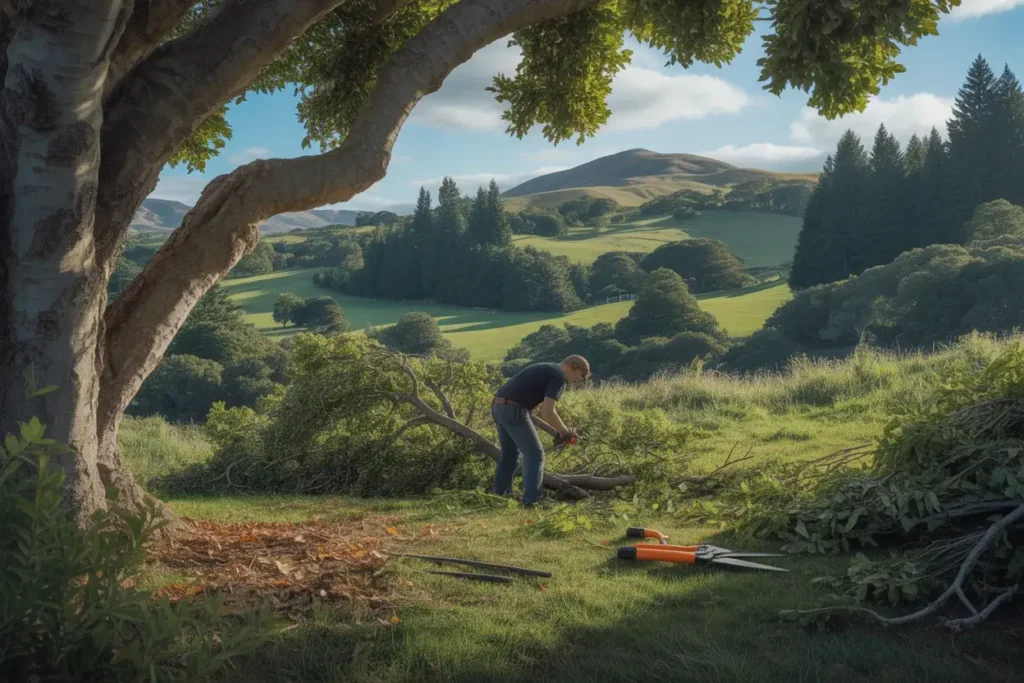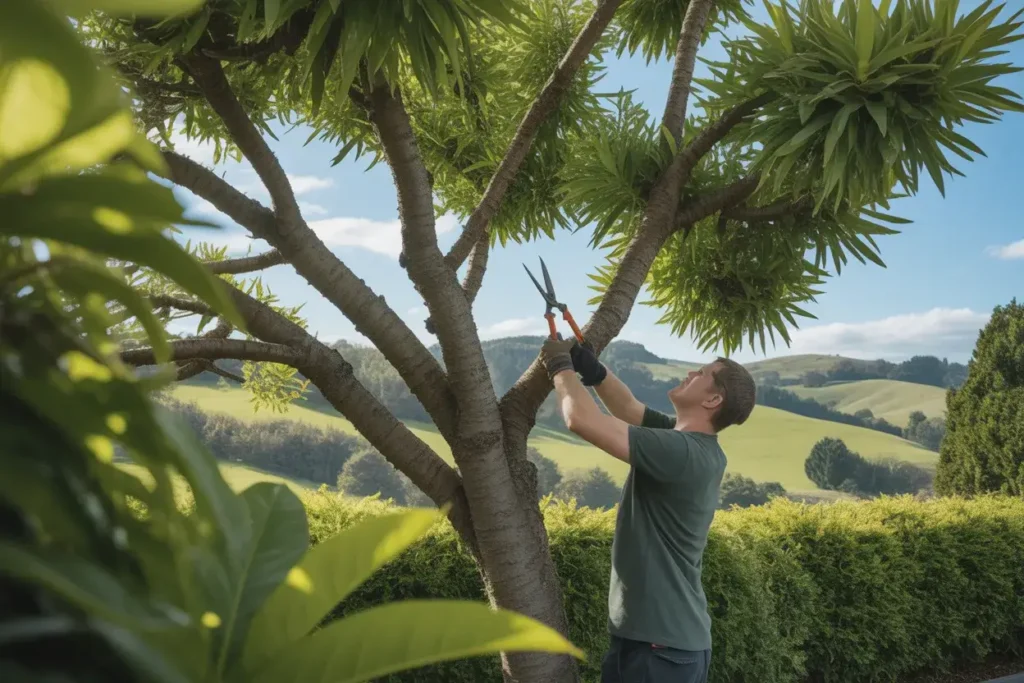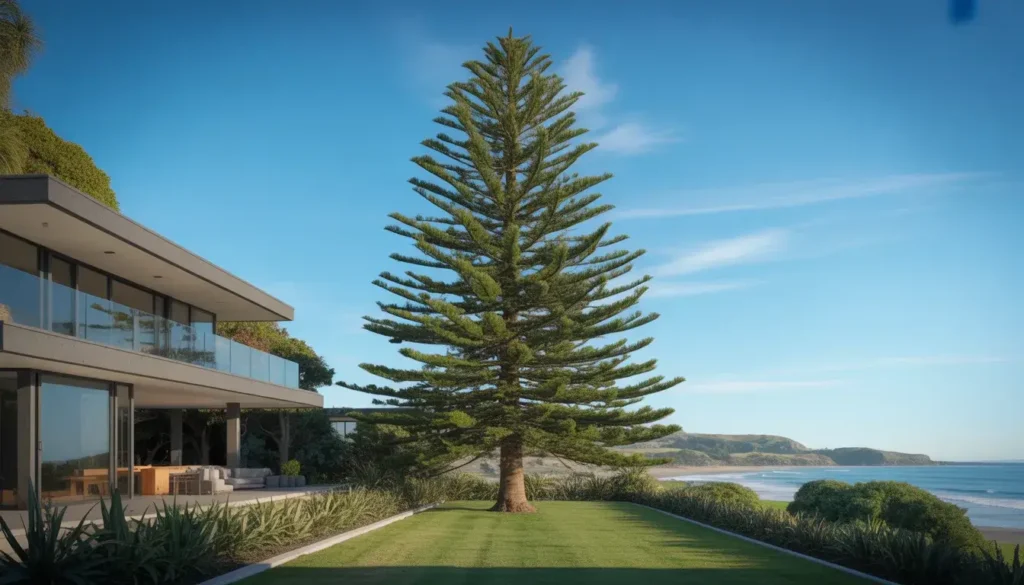Summer in Wellington brings longer days, warmer temperatures, and vibrant growth throughout your garden—including your trees. While many property owners associate tree pruning with winter dormancy, summer tree pruning plays an equally vital role in maintaining healthy, safe, and attractive trees on your property. Understanding when and how to properly trim your trees during the warmer months can make all the difference in their long-term health and appearance.
Whether you’re managing fruit trees, ornamental specimens, or large shade trees on your Wellington property, knowing the right summer tree maintenance Wellington techniques will help you make informed decisions about your arboricultural care. This comprehensive guide explores the essential practices, timing considerations, and safety requirements for summer tree pruning in the Wellington region, ensuring your trees thrive throughout the season and beyond.
Key Takeaways
- Light summer pruning is appropriate for specific tree types, particularly fruit trees after fruiting and for removing hazardous branches
- Heavy pruning should be reserved for winter dormancy to minimise stress and prevent sunburn damage
- Dead, diseased, or damaged branches can and should be removed at any time for safety reasons
- Professional arborists ensure compliance with Wellington City Council regulations and NZ Arboricultural Association standards
- Summer tree maintenance includes proper watering, mulching, and pest monitoring alongside selective pruning
- Always check if your tree is listed as heritage or notable before undertaking any pruning work
Understanding Summer Tree Pruning in the Wellington Context

Summer tree pruning differs significantly from winter pruning, both in approach and objectives. Whilst winter pruning focuses on structural development and major reshaping during dormancy, summer pruning primarily addresses immediate safety concerns, light corrective work, and specific management of fruit trees.
In Wellington’s maritime climate, summer brings unique considerations for tree care. The region experiences warm, dry periods interspersed with occasional strong winds and storms—conditions that can reveal structural weaknesses in trees that require prompt attention. Summer is also when many pests and diseases become most active, making regular tree inspection an essential part of your maintenance routine.
The New Zealand Arboricultural Association recommends that any substantial pruning work follows proper arboricultural standards, particularly the ANSI A300 Part 1 guidelines for pruning. These standards emphasise maintaining natural tree form, structural safety, and visual appearance whilst minimising stress on the tree.
When Summer Pruning Is Appropriate

Not all trees benefit from summer pruning, and understanding which situations warrant intervention during the growing season is crucial for tree health. Summer pruning should be light and strategic rather than heavy and structural.
Suitable candidates for summer pruning include:
Stone fruit trees such as peaches, nectarines, plums, and apricots respond well to pruning in mid to late summer, after fruiting has finished. This timing helps prevent the development of water shoots (vigorous vertical growth) that would occur if these trees were pruned during winter dormancy. The tree has expended its spring energy on growth and fruiting, making summer the ideal time for light corrective work.
Trees with broken, damaged, or diseased branches require immediate attention regardless of season. Wellington’s summer storms can cause branch failures, and prompt removal of damaged wood prevents further decay and potential safety hazards. Dead branches are also easier to identify during summer when the tree is in full leaf, as they stand out clearly against healthy foliage.
Young trees in their first three years after planting benefit from light formative pruning during summer. This involves cutting back approximately half of the new spring growth to encourage bushier, more vigorous development and establish a strong structural framework for future growth.
Types of Summer Pruning Work
Different pruning objectives require different approaches, and understanding these distinctions helps ensure you’re applying the right technique for your tree’s needs.
Crown cleaning and deadwooding involves removing dead, dying, diseased, or broken branches from throughout the tree canopy. Summer is actually the optimal time for this work because dead wood is readily visible against the living foliage. This maintenance improves both the tree’s appearance and its overall health by removing potential entry points for pests and diseases.
Light crown thinning can be undertaken during summer to improve air circulation and light penetration through dense canopies. This selective removal of branches helps reduce the weight at branch ends and can lower wind resistance, potentially preventing storm damage. However, crown thinning should be conservative—removing no more than 10-15% of the live foliage in any single year to avoid stressing the tree.
Clearance pruning addresses branches that interfere with buildings, power lines, footpaths, or roadways. Wellington City Council requires property owners to maintain clearance from public infrastructure, and summer pruning can address these issues as they arise. However, any work near power lines must be undertaken by qualified professionals, as regulations prohibit unauthorised persons from pruning within four metres of live conductors.
What to Avoid During Summer Pruning

Understanding what not to do during summer is just as important as knowing appropriate practices. Several pruning activities should be strictly avoided during Wellington’s warmer months.
Heavy structural pruning that removes large portions of the canopy should never be undertaken in summer. Removing substantial amounts of foliage during the growing season severely stresses the tree and exposes previously shaded bark to intense sunlight, potentially causing sunburn damage. This is particularly problematic for thin-barked species such as birch, maple, and certain native New Zealand trees.
Topping—the practice of cutting back the main leaders or removing the top of the tree—is harmful at any time but especially damaging during summer. This practice destroys the tree’s natural form, creates large wounds that struggle to heal, and stimulates masses of weak, poorly attached regrowth. The New Zealand Arboricultural Association strongly discourages topping under any circumstances.
Over-pruning removes too much of the tree’s photosynthetic capacity, essentially starving it during its most active growth period. As a general rule, never remove more than 15-20% of a tree’s live foliage during the growing season. Leaves are the tree’s food factories, and excessive removal compromises its ability to produce the energy needed for growth, defence against pests, and preparation for winter.
Essential Summer Tree Maintenance Beyond Pruning

Successful summer tree care extends well beyond pruning alone. A comprehensive approach to tree maintenance Wellington properties require includes several complementary practices.
Watering becomes critical during Wellington’s drier summer periods, particularly for newly planted trees and those established within the past two years. Deep, infrequent watering encourages strong root development, whereas frequent shallow watering promotes weak surface roots. Established trees generally don’t require supplemental watering unless conditions become exceptionally dry, but younger specimens benefit from weekly deep watering at the tree’s base, ensuring moisture reaches the root zone.
Mulching provides multiple benefits for summer tree health. A layer of organic mulch 5-10 centimetres deep (but kept away from direct contact with the trunk) helps retain soil moisture, moderate soil temperature, suppress competing weeds, and gradually improves soil structure as it decomposes. Refresh or top up mulch in early summer if your spring application has thinned.
Pest and disease monitoring becomes essential during the growing season when many problems manifest most obviously. Common summer issues in Wellington include scale insects, aphids, and fungal diseases that thrive in warm, humid conditions. Early detection allows for prompt treatment before problems escalate. Inspect your trees regularly, paying particular attention to leaf health, new growth, and the presence of unusual insects or damage patterns.
Safety and Compliance Considerations
Tree work carries inherent risks, and Wellington property owners must be aware of both safety requirements and legal obligations before undertaking any pruning work.
The Health and Safety at Work Act 2015 applies to all tree work in New Zealand, and the Approved Code of Practice for Safety and Health in Arboriculture sets out specific requirements for safe operations. Even homeowners undertaking work on their own property should follow these guidelines, which include wearing appropriate personal protective equipment (safety helmet, eye protection, sturdy footwear, and gloves) and using properly maintained tools.
Working at height presents particular hazards. Ladders must be securely positioned and, ideally, tied to the tree. Anyone climbing trees should use proper climbing equipment including appropriate harnesses that comply with AS/NZS 1891 standards. For any work beyond simple ground-level pruning or work that can be safely reached from a step ladder, engaging a professional arborist is strongly recommended.
Wellington City Council regulations protect certain trees through heritage and notable tree listings. Before undertaking any significant pruning, check whether your tree appears on the heritage list accessible through the council’s website. Listed trees require resource consent for most work beyond minor maintenance, and unauthorised pruning can result in substantial fines.

When to Call a Professional Arborist
Whilst property owners can undertake minor maintenance such as removing small dead branches or light pruning of young trees, many situations require professional expertise.
You should engage a qualified arborist for:
- Any work on large trees or work requiring climbing or elevated access
- Pruning near power lines or other utilities
- Work on heritage or notable listed trees
- Removal of large branches (generally those exceeding 50mm diameter)
- Situations where you’re uncertain about the appropriate course of action
- Trees showing signs of disease or structural problems requiring expert diagnosis
- Any work where safety concerns exist
Professional arborists possess the training, equipment, and insurance necessary to undertake tree work safely and in compliance with New Zealand standards. Members of the New Zealand Arboricultural Association and Registered Master Arborists represent the highest standards in the industry, demonstrating ongoing commitment to professional development and best practices.
Choosing the Right Time for Your Summer Pruning
Even within the summer season, timing your pruning work appropriately maximises benefits and minimises stress on your trees.
Early summer (December) suits light formative work on young trees whilst they’re actively growing and can quickly recover from pruning cuts. The extended daylight and warm temperatures promote rapid healing and vigorous regrowth.
Mid to late summer (January through February) is ideal for stone fruit trees after fruiting has completed. By this time, the tree has fulfilled its reproductive cycle for the year and can redirect energy into healing pruning wounds and preparing for the next season. This timing also minimises the risk of disease transmission that can occur during wetter periods.
Late summer into early autumn (March) provides an opportunity for final assessments before winter and can be appropriate for removing any storm-damaged branches that appeared during summer weather events. However, avoid heavy pruning at this time, as trees are beginning to prepare for dormancy and need their full complement of leaves to manufacture and store energy reserves.
Conclusion
Summer tree pruning in Wellington requires a balanced approach that respects both the tree’s biology and the region’s unique environmental conditions. Whilst winter remains the primary season for major structural work, strategic summer pruning addresses safety concerns, maintains fruit trees, and contributes to overall tree health when applied judiciously.
The key to successful summer tree maintenance Wellington properties require lies in understanding what work is appropriate for the season and, equally importantly, what should be avoided. Light, targeted interventions that remove hazardous branches, maintain clearances, and support young tree development all have their place in summer tree care. However, heavy pruning, topping, and excessive removal of live foliage should be reserved for winter dormancy when trees can better tolerate major interventions.
By combining appropriate pruning techniques with proper watering, mulching, and pest monitoring, you create conditions for your trees to thrive throughout Wellington’s summer and into the seasons beyond. When in doubt about any aspect of tree care, consulting with a qualified arborist ensures your trees receive the professional attention they deserve whilst keeping your property safe and compliant with local regulations.

Who Do I Call?
If you’re considering summer tree pruning for your Wellington property and want expert advice on the best approach for your specific trees, Elite Arboriculture offers professional arboricultural services throughout the Wellington region. Their qualified team understands local conditions, council regulations, and proper pruning techniques to keep your trees healthy and safe. For a no-obligation consultation about your tree care needs, you can reach Jade on 027 343 8846 to discuss your requirements and arrange an assessment.
Frequently Asked Questions
Can I prune my Wellington trees during summer, or should I wait until winter?
The answer depends on the type of work required and the tree species involved. Light pruning for safety reasons (removing dead, damaged, or diseased branches) can and should be done at any time, including summer. Stone fruit trees actually benefit from pruning after fruiting in mid to late summer. However, heavy structural pruning should be reserved for winter dormancy when trees are better able to tolerate major interventions without stress or sunburn damage. If you’re uncertain about timing for your specific trees, consulting a qualified arborist ensures you make the right decision.
How much can I safely prune from my trees during summer?
As a general guideline, never remove more than 10-15% of a tree’s live foliage during the summer growing season. Trees rely on their leaves to produce energy through photosynthesis, and excessive removal compromises their ability to sustain themselves, fight off pests and diseases, and prepare for winter. Dead wood can be removed without considering this percentage, as it no longer contributes to the tree’s health. For any substantial pruning work, engaging a professional arborist ensures appropriate techniques are applied.
Do I need consent from Wellington City Council to prune trees on my property?
For most trees on private property, you can undertake reasonable maintenance without council consent. However, trees listed as heritage or notable trees on the Wellington City Council’s Heritage List require resource consent for any work beyond minor maintenance. Additionally, you must ensure your trees don’t pose hazards to neighbouring properties, pedestrians, roads, or utility services. Any work within four metres of power lines requires authorisation and must be undertaken by qualified professionals. Check the council’s website or contact them directly if you’re uncertain about your specific situation.
What’s the difference between summer and winter pruning for fruit trees?
Winter pruning of deciduous fruit trees (apples, pears, quinces) focuses on structural development, encouraging fruit bud formation, and major reshaping whilst the tree is dormant. This timing is ideal for autumn-fruiting varieties. Summer pruning, applied after fruiting, works better for stone fruits (peaches, plums, apricots, nectarines) because it prevents the excessive water shoot growth that winter pruning would stimulate in these species. Summer pruning also reduces disease risk during warmer, drier conditions. The timing of your pruning should align with your tree type and your maintenance objectives.
What are the signs that my tree needs professional assessment rather than DIY pruning?
Several indicators suggest you should engage a professional arborist rather than attempting DIY work: large branches requiring removal (generally over 50mm diameter), work requiring climbing or elevated access, trees showing signs of disease or decay, structural issues such as cracks or splits in major branches, trees near power lines or buildings, heritage or notable listed trees, or situations where you’re simply uncertain about the appropriate course of action. Professional arborists have the training, equipment, and insurance necessary to safely assess and address these situations whilst ensuring compliance with New Zealand standards and local regulations.
Source Links
- New Zealand Arboricultural Association – Safety & Guidelines: https://www.nzarb.org.nz/safety-and-guidelines
- WorkSafe New Zealand – Safety and Health in Arboriculture: https://www.worksafe.govt.nz/topic-and-industry/forestry/health-and-safety-in-the-arboriculture-industry/safety-and-health-in-arboriculture/
- Wellington City Council – Heritage and Notable Trees: https://wellington.govt.nz/arts-and-culture/heritage/heritage-and-notable-trees
- Treescape – Summer Tree Care: https://www.treescape.co.nz/summer-tree-care-what-should-you-be-doing-now/
- Pro Climb – Summer Tree Pruning Tips: https://www.proclimb.co.nz/blog/tips-for-summer-tree-pruning-trimming/
- Apex Arborists – Pruning Guide: https://apexarborists.co.nz/blog/ultimate-guide-pruning-trees-arborist-nz/

